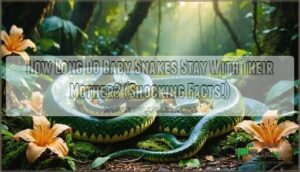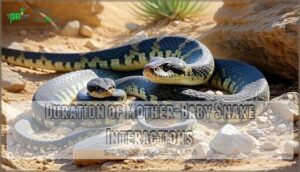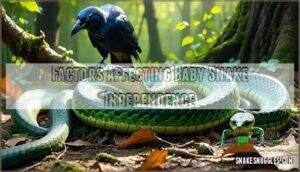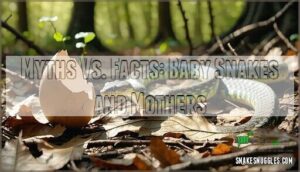This site is supported by our readers. We may earn a commission, at no cost to you, if you purchase through links.

It’s not the warm, fuzzy family situation you’d imagine. Most snake mothers follow a "good luck, kid" approach, leaving their babies to fend for themselves almost immediately after birth.
However, some species break the mold: python moms will coil around their young for up to two weeks, while rattlesnake babies might hang with mom for several weeks before going solo.
The timeline depends on the species, environment, and predator threats. Understanding these patterns reveals fascinating survival strategies, and shows that each species has its own unique approach to ensuring the survival of its young, based on factors such as the environment and predator threats, which ultimately contribute to their survival.
Table Of Contents
- Key Takeaways
- How Long Do Baby Snakes Stay With Their Mother?
- Baby Snake Behavior After Birth
- Maternal Care in Different Snake Species
- Duration of Mother-Baby Snake Interactions
- Factors Affecting Baby Snake Independence
- Survival Strategies for Newborn Snakes
- Myths Vs. Facts: Baby Snakes and Mothers
- Environmental Influences on Snake Family Dynamics
- Frequently Asked Questions (FAQs)
- When you see a baby snake, is the mother nearby?
- How soon do baby snakes leave their mother?
- Should I be worried if I see a baby snake?
- What to do when you find a baby snake in your yard?
- Do baby snakes stay near their mother?
- Do snakes stay together as a family?
- How long do baby copperheads stay with their mother?
- How long do Baby Snakes stay with their mothers?
- How long do Baby Snakes stay with their eggs?
- How long do baby rattlesnakes stay near their mother?
- Conclusion
Key Takeaways
- Most baby snakes become independent within hours to days of birth, with only a few species like rattlesnakes and pythons providing care for 1-2 weeks maximum.
- You’ll find that snake mothers follow a "good luck, kid" approach – they’re born with all the survival instincts they need to hunt, hide, and defend themselves immediately.
- Rattlesnakes and pythons break the typical pattern by offering brief protection until their babies’ first shed, while species like garter snakes provide zero maternal care after birth.
- If you spot a baby snake, don’t assume the mother’s nearby – most species abandon their young right after birth, so you’re likely seeing a fully independent youngster exploring solo.
How Long Do Baby Snakes Stay With Their Mother?
Baby snakes don’t stick around long with their mothers. Most species demonstrate Snake Precociality, meaning they’re born ready to survive independently.
Maternal care varies dramatically between species. Rattlesnakes receive protection for one to two weeks until their first Early Snake Shedding. Pythons offer brief warmth and defense, while garter snakes provide minimal care.
The snake mother typically abandons her snake offspring after birth or egg-laying. This Neonate Dispersal pattern helps baby snakes develop vital Independent Hunting skills quickly.
Snake parental care remains limited because offspring must master Post-Departure Survival strategies to thrive in challenging environments.
Baby Snake Behavior After Birth
When you observe baby snakes in their first moments after birth or hatching, you’ll notice they’re remarkably self-sufficient and ready to face the world alone.
Bold baby serpents emerge battle-ready, armed with deadly instincts and zero need for mommy’s help.
Most newborn snakes immediately begin exploring their surroundings, relying on instincts** rather than parental guidance to hunt, hide, and survive.
Rattlesnakes
Newborn rattlesnakes stick close to their mother rattlesnake for 1-2 weeks until their first shedding.
During this vital period, maternal care provides warmth and protection from predators. These baby snakes already possess deadly rattlesnake venom and natural camouflage abilities.
Despite their small size, rattlesnake aggression helps them survive. Mothers show protective behaviors post-birth, often taking cover at the slightest provocation.
Once they shed, snake offspring become completely independent hunters.
Pythons
While rattlesnakes offer brief protection, pythons break the mold entirely. These remarkable snake mothers demonstrate extraordinary parental investment through dedicated python incubation and clutch protection.
Your python breeding knowledge gets a reality check here – mothers actually provide exceptional post-hatch care, offering python warmth and protection for two weeks after their babies emerge. Southern African pythons exhibit this unique maternal behavior.
- Python mothers coil around eggs during incubation, maintaining ideal temperatures
- Parental care continues after hatching, with mothers protecting vulnerable babies
- Snake mother investment includes losing 40% of body weight during breeding cycles
- This incubation period represents the strongest snake parental care documented
Garter Snakes
Unlike pythons, garter snakes show zero maternal devotion after birth. Your garter snake babies scatter immediately, becoming fully independent within hours.
These live-born youngsters don’t stick around for family reunions – they’re too busy surviving on their own instincts.
| Garter Snake Trait | Baby Behavior |
|---|---|
| Garter Diet | Hunt insects, worms independently |
| Garter Habitats | Disperse to various environments |
| Garter Markings | Born with distinctive stripes |
| Garter Hibernation | Find winter shelter alone |
| Garter Reproduction | No snake parental care provided |
Snake offspring survival depends entirely on their natural abilities, not snake mother protection. Snake independence starts immediately after birth, and they must rely on themselves to survive.
Maternal Care in Different Snake Species
The sphere of snake maternal care varies dramatically across species, creating a fascinating spectrum of parental investment.
You’ll find that Python maternal care stands out among reptiles – these dedicated mothers coil around their eggs for months, maintaining ideal temperature and humidity.
Viper protection extends beyond hatching, with mothers staying close to their young for up to two weeks, defending them fiercely from predators.
Cobra nesting behavior shows remarkable dedication, as king cobras actually build elaborate nests before laying eggs.
Meanwhile, Garter snake behavior demonstrates brief but meaningful contact between mothers and offspring.
Some species like spine-bellied sea snakes create nurseries in shallow waters for added protection.
This maternal instinct comes at significant cost – female pythons don’t eat during their six-month breeding cycle.
Parental care in snakes challenges common assumptions about reptilian behavior, proving that each snake species has evolved unique strategies for ensuring offspring survival.
Duration of Mother-Baby Snake Interactions
Most baby snakes experience remarkably brief maternal care length compared to other animals. Species variations create fascinating differences in how long mothers stick around.
Unlike most animals, baby snakes get kicked out of the nest almost immediately—tough love at its finest.
Rattlesnakes provide the longest parental care, with mothers staying close for 1-2 weeks until their babies’ first shed. Snake mothers offer protection and warmth during this critical period, demonstrating genuine maternal instinct.
Southern African pythons show impressive snake parental investment, caring for their young for about two weeks after hatching. However, most species abandon their offspring immediately after birth.
For example, newborn snakes are independent right after birth. Post-birth dispersal happens quickly for garter snakes, where babies receive virtually no parental support.
Environmental factors and predation risks influence these timeframes, though survival rates depend more on the baby snakes’ precocial nature than extended maternal protection.
Factors Affecting Baby Snake Independence
You’ll find that several key factors determine how quickly baby snakes become independent from their mothers.
The species type, environmental conditions, and predation risks in their habitat directly influence whether young snakes stay close for days or weeks after birth, which is influenced by the species type.
Predation Risks Factors
When baby snakes enter the world, they face a gauntlet of predators that’d make your skin crawl.
Hatchling vulnerability peaks during their first weeks as fresh scent attraction draws birds, mammals, and other reptiles like magnets.
Their camouflage effectiveness becomes their lifeline, but it’s not foolproof.
Without proper hibernacula access, these tiny survivors freeze in temperate climates.
Some species, like King Cobras, exhibit limited maternal care.
Independent hunting skills develop quickly because baby snakes can’t rely on mom’s protection—snake survival strategies kick in immediately or they become someone else’s dinner.
Maternal Influence Duration
When environmental factors align favorably, some snake species extend their post-birth timeline with offspring beyond typical expectations.
Species variation plays a pivotal role – vipers maintain extended care benefits for one to two weeks until babies complete their first shed, while pythons may guard for over fifty days.
This snake maternal behavior provides evolutionary advantages through protection and thermoregulation.
Snake mother presence directly influences snake offspring development during critical early stages.
Environmental Impact Timelines
Climate change accelerates baby snake independence timelines by disrupting natural habitats.
You’ll notice these environmental pressures affecting snake offspring development:
- Habitat loss forces mothers to abandon traditional nesting sites earlier
- Pollution effects weaken maternal bonds and reduce care duration
- Urbanization impact creates fragmented snake habitats requiring faster independence
Conservation efforts now focus on protecting critical snake behavior patterns during vulnerable early-life stages.
Survival Strategies for Newborn Snakes
Most baby snakes face a sink-or-swim reality from day one. Since snake mothers provide minimal care, newborns must master snake survival tactics immediately.
Camouflage Tactics become their first line of defense. Young snakes rely on natural coloration to blend with surroundings, avoiding snake predators like birds and mammals. Initial Predation threats are highest during these vulnerable first weeks.
Temperature Regulation proves critical for survival. Baby snakes seek sunny spots to warm up and shaded areas to cool down, since they can’t regulate body heat like mammals. This snake behavior directly impacts their hunting success.
Independent Hunting starts within hours of birth. Baby snakes target insects, small lizards, and worms for their First Meal. They’re born with fully functional venom and fangs, making them surprisingly capable hunters despite their pencil-thin size. Baby snakes typically require a warm, dry environment to properly digest their meals.
You’ll find baby snakes dispersing quickly from birth sites, instinctively knowing that staying in groups attracts unwanted attention from predators.
Myths Vs. Facts: Baby Snakes and Mothers
You’ve probably heard stories about protective mother snakes guarding their babies for months, but most of these tales aren’t based on scientific facts.
The reality is that snake maternal behavior varies dramatically by species, with most mothers abandoning their offspring immediately after birth or hatching, which is a dramatic contrast to the common tales.
Common Misconceptions
You’ve likely heard myths about baby snakes that simply aren’t true.
Many people think baby snakes are more dangerous than adults, but their venom potency is actually the same.
Another widespread belief suggests finding a baby snake means the snake mother is nearby, but most species practice immediate abandonment after birth.
| Myth | Reality |
|---|---|
| Baby snakes are more venomous | Venom strength remains consistent across ages |
| Mothers stay nearby after birth | Most species abandon offspring immediately |
| Babies can’t survive alone | Precocial young have strong survival instincts |
These precocial creatures don’t need maternal presence for baby dependence – they’re born ready to hunt and defend themselves through natural survival instincts.
Scientific Observations
Research reveals fascinating snake parenting patterns.
Scientists observe that rattlesnake mothers stay with babies for 1-3 weeks, while most oviparous species abandon eggs immediately.
Livebearing snakes show brief maternal care before offspring become precocial.
| Species Type | Maternal Care Duration |
|---|---|
| Rattlesnakes | 1-3 weeks |
| Pythons | 2 weeks post-hatching |
| Most Others | None after birth |
Study limitations include observation challenges in natural habitats and the fact that some species exhibit brief maternal care.
Environmental Influences on Snake Family Dynamics
Nature’s unpredictability shapes how long baby snakes stay with their mothers through various environmental pressures.
Climate effects directly influence snake family dynamics—warmer temperatures trigger early den emergence, while harsh weather delays separation. Habitat quality determines resource availability, affecting how quickly young snakes achieve independence.
Poor snake habitat with limited prey forces extended maternal protection periods. Predator density in an area impacts snake survival strategies, with mothers staying longer in high-risk environments.
Human impact on snake parenting includes habitat fragmentation and disturbance, often forcing families into safer, more remote locations. These factors collectively influence snake behavior patterns and family bond duration, highlighting the importance of environmental pressures and snake family dynamics in shaping their behavior, with a focus on resource availability and survival strategies.
Frequently Asked Questions (FAQs)
When you see a baby snake, is the mother nearby?
Finding a baby snake doesn’t mean mom’s lurking nearby.
Most snake mothers abandon their eggs after laying or leave babies immediately after birth.
You’re likely encountering an independent youngster exploring solo.
How soon do baby snakes leave their mother?
Most baby snakes leave their mother within hours or days of birth.
You’ll find exceptions like rattlesnakes and some vipers, which stay together for about two weeks until the babies shed their first skin.
Should I be worried if I see a baby snake?
Like spotting a lone wolf pup, discovering a baby snake doesn’t mean mom’s lurking nearby.
Most snake mothers abandon their young immediately after birth, so you’re likely seeing an independent youngster just trying to survive alone.
What to do when you find a baby snake in your yard?
Stay calm and keep your distance.
Don’t handle it—baby snakes are venomous from birth.
Gently encourage it away with a broom or hose, then seal entry points to prevent future visits.
Do baby snakes stay near their mother?
Contrary to popular belief, most baby snakes don’t stay near their mothers.
They’re born independent and scatter immediately after birth.
Only a few species like rattlesnakes stick around for about two weeks.
Do snakes stay together as a family?
No, snakes don’t form traditional families.
Most species abandon their eggs or babies immediately after laying or birth.
You won’t find snake households – they’re solitary creatures who live independently from day one.
How long do baby copperheads stay with their mother?
Copper-colored youngsters don’t exactly get the royal treatment, but you’ll find baby copperheads lingering near mom for about two weeks.
They’ll stick around until their first shed, then venture off to start their independent lives.
How long do Baby Snakes stay with their mothers?
Most baby snakes leave their mothers immediately after birth or hatching. However, you’ll find exceptions like rattlesnakes and some vipers, where young stay for 1-2 weeks until their first shed.
How long do Baby Snakes stay with their eggs?
Like watching paint dry, baby snakes don’t actually stay with their eggs at all. Once they hatch, you’ll find they immediately leave their shells behind and start exploring independently.
How long do baby rattlesnakes stay near their mother?
Rattlesnake mothers protect their newborns for about 1-2 weeks until you’d see the babies shed their first skin.
During this time, they’ll huddle together for warmth and safety before becoming completely independent.
Conclusion
Surprisingly, the question of how long do baby snakes stay with their mother reveals nature’s most independent nursery system.
You’ve discovered that most snake species abandon their offspring within hours or days, though pythons and rattlesnakes extend care up to two weeks.
Understanding these maternal patterns helps you appreciate each species’ unique survival strategy.
Whether it’s immediate independence or brief protection, baby snakes quickly master the art of solo survival in their dangerous world.
- https://www.nationalgeographic.com/animals/article/python-mothers-care-for-young-southern-african-snakes-spd
- https://www.smithsonianmag.com/smart-news/study-reveals-pythons-take-care-their-offsping-little-while-180968500
- https://www.sciencedaily.com/releases/2018/03/180314102010.htm
- https://www.snakes.ngo/moms
- https://journals.plos.org/plosone/article?id=10.1371/journal.pone.0195676











